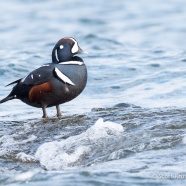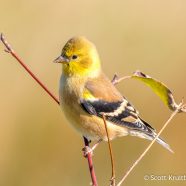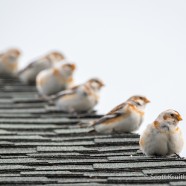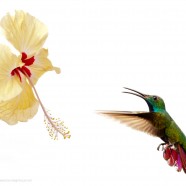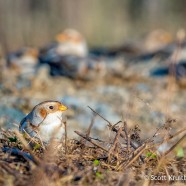Harlequin Duck at Stratford Point
Today we were fortunate enough to host a drake Harlequin Duck (Histrionicus histrionicus) at Stratford Point as found by our friend Tom Murray. I took the below photo in the later afternoon during a brief moment when the sun came out from behind the clouds. These additional shots were taken earlier in the morning under those aforementioned clouds while the duck was feeding, swimming, preening, and loving those rocks as the species always does. Harlequin Ducks are a relatively rare visitor for us in Connecticut. If it is anything like the last drake Harlequin (could it be the same bird?) that...
Read MoreAmerican Goldfinch
The summer shades may have worn away but there is still an awful lot to like about this American Goldfinch (Spinus tristis). This November bird is one of many we can enjoy even as the rest of the colors begin to fade around us. They can be one of the more confusing species to some people who see them at their feeders this time of year owing to the variability in their molt, even if those birders have their handy Peterson Field Guide. The finch’s dull and patchy winter look may seem strange as it is such a shift from their glowing gold.
Read MoreSnow Bunting Row
These Snow Buntings are all lined up and ready to launch to the north soon as they continue to molt into a brighter, whiter snowy color every day. Birds are getting their feathers set for spring and to look their best when finding a mate. What does this arrangement on the roof look like to you? Caption it!
Read MoreGreen-breasted Mango
The Green-breasted Mango (Anthracothorax prevostii) is the most common resident hummingbird species Sean encounters at Finca Pura Vida in Costa Rica. It’s an especially interesting resident because it has a slower molt than most hummingbirds, leading to a mosaic of patterns of juvenile individuals. They often appear to be stuck in between certain plumage ages. This bird is the adult male with gorgeous rich purple and blue gorget on display. Photographed by RTPI Affiliate Sean Graesser for the Meet Your Neighbours global biodiversity project in Costa Rica while on assignment for the...
Read MoreSnow Buntings
It is early enough in the avian wintering season that both the earth and the birds – in this case, Snow Buntings (Plectrophenax nivalis) – are brown. We do not have a solid snow cover yet, and it is amazing how well this plumage is designed to help them blend in to the ground. The Snow Bunting camouflage looks like brown grass and, somehow, a rocky, sandy and rough earth, with their wings showing off the darker pattern of what the tundra and short grasslands look like now. Notice how well these birds keep themselves just off the surface even while engaged in feeding, hiding their...
Read More



